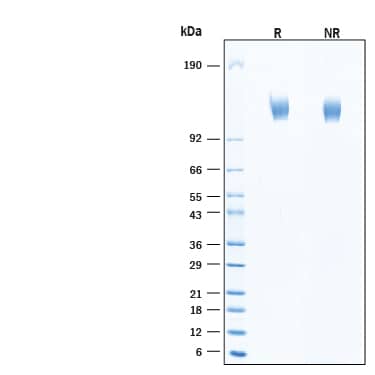Recombinant Human Aminopeptidase N/CD13 His Avi Protein, CF
R&D Systems, part of Bio-Techne | Catalog # AVI3815

Key Product Details
Source
Structure / Form
Biotinylated via Avi-tag
Conjugate
Applications
Product Specifications
Source
| Human APN (Lys69-Lys967) Accession # AAA51719.1 |
6-His tag | Avi-tag |
| N-terminus | C-terminus |
Purity
Endotoxin Level
N-terminal Sequence Analysis
Predicted Molecular Mass
SDS-PAGE
Activity
The specific activity is >5000 pmol/min/μg, as measured under the described conditions.
Measured by its binding ability in a functional ELISA.
Biotinylated Recombinant Human Aminopeptidase N/CD13 His-tag Avi-tag (Catalog # AVI3815) binds Human Aminopeptidase N/CD13 Antibody (Catalog # AF3815) with an ED50 of 1.80-18.0 ng/mL.
Scientific Data Images for Recombinant Human Aminopeptidase N/CD13 His Avi Protein, CF
Biotinylated Recombinant Human Aminopeptidase N/CD13 His-tag Avi-tag Protein Binding Activity.
Biotinylated Recombinant Human Aminopeptidase N/CD13 His-tag Avi-tag Protein (Catalog # AVI3815) binds Human Aminopeptidase N/CD13 Antibody (AF3815) with an ED50 of 1.80-18.0 ng/mL.Biotinylated Recombinant Human Aminopeptidase N/CD13 His-tag Avi-tag Protein Enzyme Activity.
Biotinylated Recombinant Human Aminopeptidase N/CD13 His-tag Avi-tag Protein (Catalog # AVI3815) is measured by its ability to cleave the fluorogenic peptide substrate, Ala-7-amido-4-methylcoumarin (Ala-AMC).Biotinylated Recombinant Human Aminopeptidase N/CD13 His-tag Avi-tag Protein SDS-PAGE.
2 μg/lane of Biotinylated Recombinant Human Aminopeptidase N/CD13 His-tag Avi-tag Protein (Catalog # AVI3815) was resolved with SDS-PAGE under reducing (R) and non-reducing (NR) conditions and visualized by Coomassie® Blue staining, showing bands at 116-130 kDa, under reducing conditions.Formulation, Preparation and Storage
AVI3815
| Formulation | Supplied as a 0.2 μm filtered solution in MES and NaCl. |
| Shipping | The product is shipped with polar packs. Upon receipt, store it immediately at the temperature recommended below. |
| Stability & Storage | Use a manual defrost freezer and avoid repeated freeze-thaw cycles.
|
Background: Aminopeptidase N/CD13
Aminopeptidase N (APN) is a type II transmembrane zinc-dependent metalloprotease that is widely expressed in many cells, tissues, and species. APN forms an active homodimer where each monomer contains a short cytoplasmic tail, a transmembrane region, and an extracellular domain with a Ser/Thr rich region and a metalloprotease catalytic domain (1,2). APN is also known as leukocyte surface differentiation antigen CD13, microsomal aminopeptidase, alanyl aminopeptidase, and aminopeptidase M (1-3). The protein cleaves the N-terminal neutral amino acids from bioactive peptides like neuropeptides and immunomodulatory peptides including oxytocin, vasopressin, angiotensin III, and tuftsin resulting in their degradation or modulation (2,4). Consequently, APN is implicated to play many biological roles within the immune system, angiogenesis, mestastasis, and cancer (2). Both APN expression and activity are altered in cancer making it a marker and a pharmacological intervention target (5,6). It is targeted in CAR T therapies for cancers such as B-cell lymphoma and multiple myeloma (2,7). In addition, APN serves as a receptor for several human viruses such as coronavirus 229E (8) and human cytomegalovirus making it of interest as a target in these fields (9,10).
References
- Look, A.T. et al. (1989) J. Clin. Invest. 83:1299.
- Lendeckel, U. et al. (2023) Biomedicines. 11:724.
- Olsen, J. et al. (1988) FEBS Lett. 238:307.
- Hansen, A.S. et al. (1993) Eur. J. Immunol. 23:2358.
- Li, H. et. al. (2019) Chem. Sci. 10:1619
- Shimizu, T. et. al. (2024) Front. Surg. 11:1298709.
- He, X. et. al. (2020) Blood 135:713.
- Yeager, C.L. et. al. (1992) Nature 357:420.
- Soderberg, C. et. al. (1993) J. Virol. 67: 6576
- Fu, Z. et. al. (2024) J. Virol. 98:e0123923.
Alternate Names
Gene Symbol
Additional Aminopeptidase N/CD13 Products
Product Documents for Recombinant Human Aminopeptidase N/CD13 His Avi Protein, CF
Product Specific Notices for Recombinant Human Aminopeptidase N/CD13 His Avi Protein, CF
For research use only


